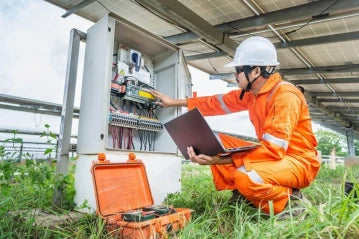
Ensuring that your solar panel is effectively charging the battery is crucial for optimal energy production and utilization. In this blog, we will provide you with a comprehensive guide on how to check if your solar panel is charging the battery. We will cover important steps to inspect the battery, examine the solar panel, check the solar charge controller, and verify the connecting wires. By following these steps, you will be able to identify any potential issues and take appropriate measures to resolve them. Let's dive in and learn how to assess the charging status of your solar panel.
Check the Battery
To begin with, inspect the battery to ensure it is properly connected. If there is any corrosion present, both internally and externally, it may hinder the charging process. Loose wires between the solar panels and battery terminals can also cause this problem.
For better clarity, use a digital multimeter to examine the battery. If it is charging, the voltage will increase. Alternatively, the multimeter will display a solar output voltage of 15 V or higher. Reduced battery backup due to over-discharging or deposits can also cause the battery to stop functioning. In such cases, contact the customer care of your battery for assistance. If the battery is still under warranty, consider requesting a replacement.

Follow these steps to check the battery:
- Begin by disconnecting the battery from the solar panel connection and use appropriate tools to remove the screws. Safely separate the battery, ensuring there are no short circuits.
- Activate the multimeter and select the DC voltage sensing mode. Measure the battery voltage and record the value.
- Reconnect the solar panel wires to the battery and allow the battery to charge for at least 20 minutes to 1 hour.
- After the designated time, recheck the battery voltage and compare it with the previous reading.
- If the battery voltage after connecting the solar panel is higher than the disconnected state, it indicates that the battery is being charged by the solar panel. Otherwise, there may be issues with the wires, battery, or even the solar panel itself.
Checking Solar Panel
To ensure proper charging of the battery, it is important to examine the solar panel. Insufficient current and voltage from the solar panel can result in charging issues. Therefore, it is necessary to check for any cracks or issues on the solar panel and also verify its voltage.
Here are the steps to check the solar panel:
- Begin with a visual inspection to identify any damage or cracks on the solar panel. If everything appears fine, proceed to measure its voltage.
- Connect the multimeter probes to both ends of the solar panel's output pins. Position the solar panel face towards the sunlight. The output voltage should be within the range of 10 to 18V DC.
- If the solar panel falls within this voltage range, it indicates that it is in good working condition. Additionally, check the amperage of the solar panel by connecting a 12V bulb and a multimeter in series.
- If the voltage is within the normal range but no amperage is detected, it suggests that the solar panel cells may have internal disconnections or the cells may be dead.
Checking Solar Charge Controller
A faulty solar charge controller can hinder battery charging. Advanced solar charge controllers, such as PWM and MPPT chargers, feature a display that indicates errors. If a fault is detected, the controller may emit beeping sounds or flash warning lights.
To check the solar charge controller, follow these steps:
The solar charge controller serves as the central unit for the charging process. Any internal faults within the charge controller can disrupt battery charging.
- Begin by visually inspecting the ampere and voltage readings displayed on the solar charge controller.
- Determine the voltage and ampere values being utilized for battery charging.
- If there are any inconsistencies or abnormalities on the charge controller screen, it indicates an error with the controller unit, necessitating a replacement.
Checking Connecting Wires
In many cases, when the solar DC cable becomes damaged, solar power fails to reach the battery. To resolve this issue, examine the wiring connections of the solar panels. Use a multimeter to verify the continuity of the wires. If the wires demonstrate good connectivity, it means they are effectively transmitting power. It is recommended to use a minimum of 4 square mm wire for connecting the solar panels to minimize energy loss during transmission. With these steps, you have successfully learned how to check if the solar panel is charging the battery. Now, let's address the question of what might be wrong with your solar charge controller.
Conclusion
In conclusion, monitoring the charging process of your solar panel is essential to ensure the efficient utilization of solar energy. By thoroughly inspecting the battery, examining the solar panel, checking the solar charge controller, and verifying the connecting wires, you can identify any potential obstacles that may hinder the charging process. Regular maintenance and troubleshooting will help you maintain the optimal performance of your solar panel system. Remember, a well-functioning solar panel that charges the battery effectively translates to reliable and sustainable energy usage. With the knowledge gained from this guide, you are now equipped to assess the charging status of your solar panel and take the necessary steps to address any issues that may arise. Enjoy the benefits of renewable energy and harness the power of the sun!
Ecgsolax has established itself as a leading manufacturer in the renewable energy industry, constantly striving for innovation in the pursuit of a cleaner and greener future.
At Ecgsolax, we make some of the best batteries on the market, so whether you’re looking for lithium-ion batteries, AGM batteries, or gel batteries, we’ve got you covered.

0 comments